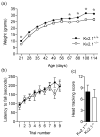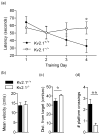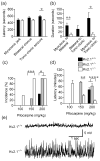Deletion of the Kv2.1 delayed rectifier potassium channel leads to neuronal and behavioral hyperexcitability
- PMID: 24494598
- PMCID: PMC4077602
- DOI: 10.1111/gbb.12120
Deletion of the Kv2.1 delayed rectifier potassium channel leads to neuronal and behavioral hyperexcitability
Abstract
The Kv2.1 delayed rectifier potassium channel exhibits high-level expression in both principal and inhibitory neurons throughout the central nervous system, including prominent expression in hippocampal neurons. Studies of in vitro preparations suggest that Kv2.1 is a key yet conditional regulator of intrinsic neuronal excitability, mediated by changes in Kv2.1 expression, localization and function via activity-dependent regulation of Kv2.1 phosphorylation. Here we identify neurological and behavioral deficits in mutant (Kv2.1(-/-) ) mice lacking this channel. Kv2.1(-/-) mice have grossly normal characteristics. No impairment in vision or motor coordination was apparent, although Kv2.1(-/-) mice exhibit reduced body weight. The anatomic structure and expression of related Kv channels in the brains of Kv2.1(-/-) mice appear unchanged. Delayed rectifier potassium current is diminished in hippocampal neurons cultured from Kv2.1(-/-) animals. Field recordings from hippocampal slices of Kv2.1(-/-) mice reveal hyperexcitability in response to the convulsant bicuculline, and epileptiform activity in response to stimulation. In Kv2.1(-/-) mice, long-term potentiation at the Schaffer collateral - CA1 synapse is decreased. Kv2.1(-/-) mice are strikingly hyperactive, and exhibit defects in spatial learning, failing to improve performance in a Morris Water Maze task. Kv2.1(-/-) mice are hypersensitive to the effects of the convulsants flurothyl and pilocarpine, consistent with a role for Kv2.1 as a conditional suppressor of neuronal activity. Although not prone to spontaneous seizures, Kv2.1(-/-) mice exhibit accelerated seizure progression. Together, these findings suggest homeostatic suppression of elevated neuronal activity by Kv2.1 plays a central role in regulating neuronal network function.
Keywords: Hyperactivity; Kcnb1; Kcnb1tm1Dgen; long-term potentiation; seizure.
© 2014 John Wiley & Sons Ltd and International Behavioural and Neural Genetics Society.
Figures








Similar articles
-
Regulation of intrinsic excitability in hippocampal neurons by activity-dependent modulation of the KV2.1 potassium channel.Channels (Austin). 2009 Jan-Feb;3(1):46-56. doi: 10.4161/chan.3.1.7655. Channels (Austin). 2009. PMID: 19276663 Free PMC article.
-
Heterogeneity in Kv2 Channel Expression Shapes Action Potential Characteristics and Firing Patterns in CA1 versus CA2 Hippocampal Pyramidal Neurons.eNeuro. 2017 Aug 24;4(4):ENEURO.0267-17.2017. doi: 10.1523/ENEURO.0267-17.2017. eCollection 2017 Jul-Aug. eNeuro. 2017. PMID: 28856240 Free PMC article.
-
Calcium- and metabolic state-dependent modulation of the voltage-dependent Kv2.1 channel regulates neuronal excitability in response to ischemia.J Neurosci. 2005 Nov 30;25(48):11184-93. doi: 10.1523/JNEUROSCI.3370-05.2005. J Neurosci. 2005. PMID: 16319318 Free PMC article.
-
Kv2.1: a voltage-gated k+ channel critical to dynamic control of neuronal excitability.Neurotoxicology. 2005 Oct;26(5):743-52. doi: 10.1016/j.neuro.2005.02.003. Epub 2005 Jun 9. Neurotoxicology. 2005. PMID: 15950285 Review.
-
Dynamic regulation of the voltage-gated Kv2.1 potassium channel by multisite phosphorylation.Biochem Soc Trans. 2007 Nov;35(Pt 5):1064-8. doi: 10.1042/BST0351064. Biochem Soc Trans. 2007. PMID: 17956280 Review.
Cited by
-
The involvement of K+ channels in depression and pharmacological effects of antidepressants on these channels.Transl Psychiatry. 2024 Oct 2;14(1):411. doi: 10.1038/s41398-024-03069-6. Transl Psychiatry. 2024. PMID: 39358318 Free PMC article. Review.
-
The modulation of potassium channels by estrogens facilitates neuroprotection.Front Cell Dev Biol. 2022 Oct 26;10:998009. doi: 10.3389/fcell.2022.998009. eCollection 2022. Front Cell Dev Biol. 2022. PMID: 36393851 Free PMC article. Review.
-
AMIGO-Kv2.1 Potassium Channel Complex Is Associated With Schizophrenia-Related Phenotypes.Schizophr Bull. 2016 Jan;42(1):191-201. doi: 10.1093/schbul/sbv105. Epub 2015 Aug 3. Schizophr Bull. 2016. PMID: 26240432 Free PMC article.
-
Spectrum of KV 2.1 Dysfunction in KCNB1-Associated Neurodevelopmental Disorders.Ann Neurol. 2019 Dec;86(6):899-912. doi: 10.1002/ana.25607. Epub 2019 Oct 24. Ann Neurol. 2019. PMID: 31600826 Free PMC article.
-
The Role of the Voltage-Gated Potassium Channel Proteins Kv8.2 and Kv2.1 in Vision and Retinal Disease: Insights from the Study of Mouse Gene Knock-Out Mutations.eNeuro. 2019 Feb 25;6(1):ENEURO.0032-19.2019. doi: 10.1523/ENEURO.0032-19.2019. eCollection 2019 Jan-Feb. eNeuro. 2019. PMID: 30820446 Free PMC article.
References
-
- Antonucci DE, Lim ST, Vassanelli S, Trimmer JS. Dynamic localization and clustering of dendritic Kv2.1 voltage-dependent potassium channels in developing hippocampal neurons. Neuroscience. 2001;108:69–81. - PubMed
-
- Ariano MA, Cepeda C, Calvert CR, Flores-Hernandez J, Hernandez-Echeagaray E, Klapstein GJ, Chandler SH, Aronin N, DiFiglia M, Levine MS. Striatal potassium channel dysfunction in Huntington’s disease transgenic mice. J Neurophysiol. 2005;93:2565–2574. - PubMed
-
- Beaudoin GM, 3rd, Lee SH, Singh D, Yuan Y, Ng YG, Reichardt LF, Arikkath J. Culturing pyramidal neurons from the early postnatal mouse hippocampus and cortex. Nature protocols. 2012;7:1741–1754. - PubMed
Publication types
MeSH terms
Substances
Grants and funding
LinkOut - more resources
Full Text Sources
Other Literature Sources
Medical
Molecular Biology Databases
Miscellaneous

